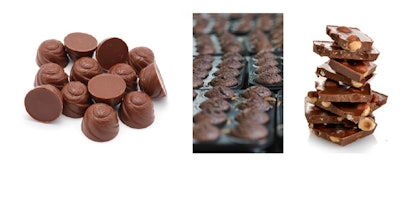
Chocolate can be found in an incredible array of foodstuffs, from confectionary and baked goods
to dairy and more. While chocolate is generally a solid at room temperature, those who move and apply
chocolate in their products generally use pumps to handle it in a liquid state. Selection and application
of chocolate pumps requires some experience and expertise. Many different forms of chocolate may
require very different pumping technologies, materials, and operational strategies. This white paper
will provide you with some of the tools and background for selecting and operating appropriate
pumping technologies to make your chocolate transfer applications successful.
Given that chocolate is shear sensitive, viscous, solid at ambient temperature, and is used for
human consumption, key requirements include the ability to:
• move the chocolate with as little shear force as possible to prevent separation of the cocoa
butter from the cocoa solids, or otherwise degrade the material properties;
• create sufficient vacuum to draw liquid chocolate into the suction side of the pump;
• force it out of the pump against system pressure to get it to the next step of the process;
• melt solid chocolate remaining within the pump before startup, without burning it;
• and, comply with applicable hygiene regulations to ensure health and safety for the consumer.
Shear Sensitivity
The rate of shear is proportional to the speed of the pump. The need to minimize shear forces on
the liquid immediately limits your pump selection to Positive Displacement (PD) pumps operating at
slow speeds, typically less than 300 RPM. As centrifugal pumps operate at high speeds, typically greater
than 1400 RPM, the shear in these pumps is too high for chocolate handling applications.
PD pumps create chambers that expand to draw liquid in, and then contract to force liquid out.
They include both reciprocating pumps, like piston and diaphragm pumps, and rotary pumps, like gear
and lobe pumps. Check valves and acceleration forces in reciprocating pumps create shear, which
usually eliminates them from consideration. Rotary positive displacement pumps are generally used for
chocolate because the moving parts operate at very slow speeds, thus imparting minimal shear to the
product.
Chocolate Handling Tips for Food Processors
Discharge pressure also creates shear through the pump clearances. Pressure should always be
minimized to prevent separation of the chocolate and cocoa butter. This can be done by avoiding
restrictions in the piping system that would create unnecessary backpressure. Discharge pressure
should be less than 100 PSI (7 bar), and preferably much lower.
Viscosity
Fortunately, Rotary PD pumps excel at handling high viscosity liquids like chocolate. The ability to
get a viscous liquid into the pump is a function of the pump’s Net Positive Suction Head Required, or
NPSHr. Like shear rate, the NPSHr of a pump also correlates to its speed. Pumps that run slowly to
minimize shear will also have lower NPSHr than higher speed pumps. Handling high viscosity chocolates
may also require special high strength materials of construction in the pump, like steel rotors.
Temperature Control
Solidified chocolate in the pump left over from its last operation must be melted prior to startup.
This process is similar to melting chocolate in a double boiler on the stove. Using a pump with jacketed
features (cavities within the pump that do not allow direct contact with the chocolate) allows you to
circulate hot water, low pressure steam or other heat transfer media through the jacketing to heat the
pump, thus melting the solid chocolate inside. Significant damage to the pump can occur if the
chocolate is too viscous, or solid, prior to startup. Iron pumps will melt chocolate faster than stainless
steel pumps due to the higher thermal conductivity of the iron. Just as you would not heat chocolate
directly in a pan on a stovetop burner, avoid applying point sources of heat like torches or electric heat
tracing to a pump, since that can burn the chocolate.
Hygiene
For many decades, the go-to pump for chocolate processors has been a cast iron internal gear
pump with packed gland. The fat portion of chocolate, the cocoa butter, has lubricating properties that
make it suitable for using gear pumps. When compared to a gear, lobe, or circumferential piston pump
constructed of stainless steel, cast iron internal gear pumps provide both greater reliability and lower
cost by offering non-galling materials and a single shaft seal design. Cast iron gear pumps are available
conforming to EN1935, an EU standard limiting leaching of hazardous materials from equipment into
food. Because chocolate pumps are generally not cleaned with caustic, acidic, or chlorinated solutions,
corrosion is not an issue. Iron or steel components are acceptable materials of construction in that they
do not leach harmful materials into food. However, the FDA does not include iron as an acceptable food
contact material since most other food processes require frequent cleaning. If you require FDA
conformance, internal gear pump are available in stainless steel with all FDA conforming materials.
Chocolate shares many characteristics with edible oils. One that makes it attractive to
manufacturers is that is has a long shelf life, because is not a good growth medium for bacteria or fungi.
This means that unlike most other food processing equipment, chocolate processing systems rarely
need to be cleaned. In fact, introducing water into the system, like using a Clean-In-Place (CIP) process,
can actually create conditions favorable to contamination. Even Cleaning-Out-of-Place (COP), if the
components are not dried sufficiently after cleaning, can introduce water. Because of this very low
hazard of contamination, a facilities’ Hazard Analysis and Critical Control Point (HACCP) plan can allow
use of “industrial” pumps for handling chocolate liquor, as long as their construction does not include
materials that can leach out in concentrations hazardous to human health. When there is a potential
contamination hazard, such as with dairy products in milk chocolate, that should be reflected in the
HACCP plan and hygienic pumps should be used.
Gear pumps made of stainless steel are needed when a hygienic design is required due to the type of
chocolate or additive being processed. Hygienic design means not only that it confirms to FDA
requirements, but that it is cleanable using CIP and/or COP methods. Hygienic design can be ensured by
using pumps that comply with third party certifications. There are two key third party certifiers in the
food industry: 3-A and EHEDG. CIP-ability can be ensured by using pumps that have been validated
under the European Hygienic Engineering and Design Group (EHEDG) Type EL Class 1 standard.
Gear pumps are generally selected for low cost, reliability, and ease of maintenance, but they are
not well suited to handling solids. Lobe and circumferential piston pumps create larger fluid cavities that
can pass large, soft solids like whole peanuts in chocolate. With two shafts and two shaft seals, they are
more complex than gear pumps but are an excellent choice where both hygienic design and solids
handling are required.
The simplest and most reliable shaft seal for chocolate is a packed gland using food grade packing.
Shaft packing must be loose enough that some chocolate leaks out to cool and lubricate the packing, up
to a rate of 1 drop per minute. As the chocolate leaks out, it cools and hardens which eventually creates
a puddle in either a collection tray or around the base of the pump. While packing may be allowed by
your facilities’ HACCP plan, it is not considered hygienic according to 3-A or EHEDG. If you must have
3-A or EHEDG compliance, or you want to avoid the aesthetics of leakage, the next best option is using
dynamic O-ring seals on the shaft(s). O-ring seals are low cost, minimize leakage, and can handle high
viscosities. Mechanical seals are a last resort. If the chocolate at the seal faces is not completely melted
at startup, it can damage the seal(s). The sugars in the chocolate can also crystallize at the seal faces
which can lead to damage.
Helpful Hints
Some tips for keeping your chocolate flowing:
• Allow plenty of time for the heating of the pump before startup to ensure chocolate is
completely melted in the pump, at the seals, and through the piping. Many failures occur
due to impatient operators.
• Follow manufacturer recommendations for maximum speed. Depending on the pump size,
the chocolate, and the application, typical speeds range from 50 to 300 RPM.
• Design the system to allow the pump to be close to the source tank and provide minimal
discharge pressure. Provide some means of system overpressure protection. Internal
pressure relief valves are not recommended due to potential product buildup.
• Follow manufacturer recommendations for pump design and materials of construction
required for the specific grade of chocolate. Many chocolates are abrasive and require hard
materials. Occasionally, external lubrication using cocoa butter or coconut oil may be
required to prevent product buildup in close tolerances at bushings.
• Through a combination of reliability and low cost, a cast iron gear pump offers the greatest
value if you are handling a low hazard material. Hygienic gear, lobe, and circumferential
piston pumps are suitable alternatives when handling products with a higher potential for
bacterial growth.
• Variable speed drives enable easy, manual or automatic remote control of flow rate, since
flow is directly proportional to speed in a PD pump.



















